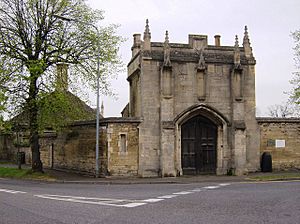Greyfriars, Stamford facts for kids
Greyfriars, Stamford was a Franciscan friary in Lincolnshire, England. A friary is a type of monastery where friars (members of religious orders) lived and worked. This friary was one of many religious houses in Stamford that were closed down during the Dissolution of the Monasteries. This was a time in the 1530s when King Henry VIII closed many monasteries and friaries across England.
The Franciscan Friary was started before 1230. We know this because King Henry III gave them permission to collect wood for fires in January 1230. The friary was officially closed in 1534 and fully handed over to the King in 1538.
Important Burials
Several important people were buried at Greyfriars.
Joan of Kent, who was the wife of Edward, the Black Prince, was buried here in 1385. She was laid to rest next to her first husband, Thomas Holland, 1st Earl of Kent, just as she had asked in her will.
Richard, Duke of York, was a powerful noble who died in the Battle of Wakefield in 1460. Years later, in 1476, his son, King Edward IV, had his body dug up. A grand funeral procession then traveled from Pontefract to a new tomb at Fotheringhay. On its way, the hearse carrying his body stayed for two nights at the Greyfriars church.
Other Burials
The Gatehouse
The only building that might still be left from the old friary is a gatehouse. This gatehouse is now part of the Stamford and Rutland Hospital, which was first started in 1828 on the same site where the friary once stood. For a long time, people thought this building was the "Whitefriars gatehouse." However, research in the late 1900s showed that the Franciscans were actually on this site. The gatehouse was built from Barnack limestone in the early to mid-1300s.
Today, the gate is on the Heritage at Risk Register. This means it's an important historical building that needs special care and attention. Repairs have been done, but the building is not yet being used for anything new.



